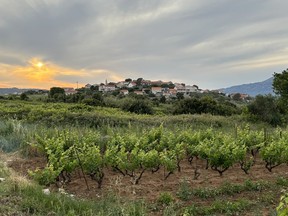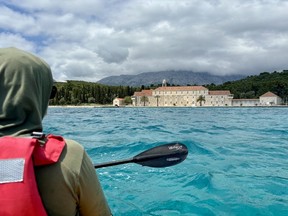
Article content
“Marco.” “Polo.” These are two words that travellers might expect to hear when lounging at hotel pools as children play the popular water tag game.
Advertisement 2
Article content
Article content
Recommended Videos
Article content
Hearing “Marco Polo” while walking the cobblestone lanes of the beautiful and historic Korcula Old Town on the Croatian island of Korcula, however, was a surprise to me. As the locals tell it, the famous merchant and explorer – who most believe to be Venetian – was actually born here.
But first let’s explain where here is. Korcula is in southern Dalmatia (a region of Croatia along the Adriatic Sea) and is the second-largest Croatian island with around 15,000 inhabitants. It’s nearly 47 km long and covers 276 square kilometres. The island gets typical Mediterranean weather, with lots of sunshine and average temperatures of about 27C in the summer and 9C in the winter.

Korcula’s history goes back thousands of years (indeed a submerged 7,000-year-old Neolithic site was discovered just off the island and is currently being explored) but in the more modern age, the fortified Old Town was built in the 13th century in a strategic position for ships sailing from the Mediterranean Sea to Venice. The main street goes through the centre and the side streets are laid out in the form of a fishbone due to the winds. Only one street is without stairs (known as ‘The Street of Thinkers’ since you don’t have to watch your step) and about 115 people live in the Old Town (while around 5,700 live in the Town of Korcula). Old Town shops are only open from Easter to mid-October.
Article content
Advertisement 3
Article content

Some parts of the Old Town’s high walls remain along with eight fortresses (TIP: have a drink at Massimo cocktail bar at the top of Zakerjan Tower where you climb a ladder through a hole in the floor to the turret and drinks are brought up the outside wall with a dumbwaiter – super cool experience!). The bell tower of the Gothic and Renaissance building of St. Mark’s Cathedral, constructed by local stonemasons in the 14th, 15th and 16th centuries, rises above the Old Town’s orange terracotta roofs.
For history buffs, it’s pure joy. Three brotherhoods – including one founded in 1301 – take part in processions throughout the year, and the Moreska sword dance by local males depicting a mock battle is performed during the summer tourist season. You can learn all about the island and the Old Town in the recently renovated town museum, and the Marco Polo Interpretation Centre opened in 2023.
Advertisement 4
Article content

Oh yes, Marco Polo. The centre makes the case that his family’s origins are Korcula and his birth in 1254 was actually on this island. Whether you accept that or not, the centre provides a lot of information about his travels and influence. One thing that is for certain is he was captured by the Genovese army in the naval battle of Venice in 1298 and held in the Prison Tower that is part of the southern Old Town walls, so don’t miss taking a peek.
Beyond the intriguing history of Korcula are the island’s many outdoor activities, which we dove headfirst into with the informative guides of Korcula Outdoor Experience.
To start, we took an electric bike tour (which was my first time on an ebike and I have to say I’m pretty annoyed at myself for all the years I powered a bike with my own exertion!), which included two stops I especially enjoyed. The first was St. Anthony Hill, where you can climb 101 stone steps lined with cypress trees planted in 1708 to the top. The reward is the humble yet locally significant 15th-century chapel of St. Anthony as well as views of Old Town, the Peljesac peninsula, and the nearby village of Lumbarda, site of the second stop I fancied.
Advertisement 5
Article content

Lumbarda, about 6 km from the Town of Korcula, has about 1,000 residents and eight wineries producing the delicious white Grk wine, from grapes of the same name. We had a tasting with charcuterie at family-owned Bire Winery – one of more than two dozen wineries on the island – and luckily my backpack accommodated my purchases for the cycle back to town!

The next day we met our guides on a gorgeous pebble beach to go kayaking. The Adriatic Sea is stunning – vibrant blue and clear – and though a little wavy at times, no one in our group went in the drink. We did, however, stop to drink on the island of Vrnik, in the Korcula archipelago, home to fascinating abandoned limestone quarries and the Vrnik Arts Club, where you can see the old schoolhouse, enjoy a meal and even book a stay.
Korcula island is 60% tree covered, offering plenty of trails for hiking. We did one that took us along old roads with old retaining walls and fabulous sea views to Kocje, a 4.6-hectare nature park with cool caves, trees and rocks. We then made our way to Zrnovo village, about 4 km from the Town of Korcula, where we visited Eko Skoj family farm and learned how olive oil is made and sampled the varieties with delicious dishes (and played with their cats!).
Advertisement 6
Article content

WHERE TO STAY
We stayed at Aminess Liburna Hotel, perched on a peninsula with a fabulous view of the Old Town, which is a short walk away along the shoreline. It has an outdoor pool, and the restaurant offers buffet or a la carte meals.

IF YOU GO
Croatia has been voted by European Best Destinations travellers as the best country to visit in Europe in 2025, and I can concur – it’s well worth a visit (or two)!
From Pearson airport, Air Transat is the only airline to operate Toronto-Zagreb direct flights. The nearly-nine-hour route flies up to three times weekly in 2025 from May 17 to Oct. 11. From Zagreb, I flew Croatia Airlines to Split and took a catamaran to Korcula. However, I also had a few hours to explore the Croatian capital and did my best to make the most of them.
I took an Uber from the airport to the train station, where there are lockers for luggage. It was early, so I paused during my stroll for a cappuccino on a cafe patio (the local men next to me were starting their day with beer and wine – hey, it was a Sunday, in all fairness!). I walked up to the historical Upper Town area where I admired St. Mark’s Church and visited the Museum of Broken Relationships, where people around the world send in mementoes and share their emotional stories of lost love.
Advertisement 7
Article content

After that I perused the outdoor weekend Antiques and Art Fair at Britanac Square in the city centre, which had a vibrant atmosphere with locals and tourists alike shopping the unique offerings that would make cool souvenirs or gifts.
I then walked to the Museum of Illusions – the original one whose franchise has spread globally (including a location in Toronto) – and had some Instagram-worthy fun.
The architecture, trolleys and gardens of Zagreb deserve more time than I had this visit, but I’d definitely return again!
Find out more at visitkorcula.eu and croatia.hr/en-gb.
Article content


